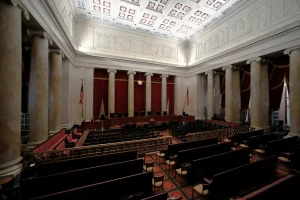Content Reviewed by:
Tucker Clagett •
June.24.2022
Vertified Content
Jun 24, 2022
| Read Time: 13 minutes
NOTE & UPDATE: This article was originally published on October 26, 2021, right before the Supreme Court heard oral arguments on the case that would eventually overturn Roe v. Wade.
We predicted the court would overturn Roe. We were right. Today, the court did overturn Roe v. Wade.
So, what does that mean in Maryland? What does it mean nationally? How did we get here?
If you want a good, very non-political, analysis of abortion law, we have provided one here. We will first tell you what happens in Maryland now that Roe is no longer the law of the land. Then we explain the background of abortion law and how we got here. We will not take political sides, or be biased in any way. We will simply explain the legal issues at stake here.
In our opinion, everyone should know these basics. We know most people will have strong beliefs one way or the other. But if you are arguing about a constitutional law you should have some background on it that is free from the bias that will inevitably find its way into almost every news article you will read the next few weeks. We can give that to you here.
The Dobbs Decision Today
The Dobbs decision today did overturn Roe v. Wade. That decision says the constitution is silent on abortion, and therefore the court takes no stance on it one way or the other. The constitution does not allow abortion, or deny abortion. It is simply silent on it, and therefore the right to abortion granted by Roe is no longer a constitutional right.
It is important to understand that this decision does not make abortion illegal. It simply means that each state will get to decide if abortion is legal or not. And the states will be able to impose restrictions on abortion. Some states already have restrictions on the books that are not valid under current law, and may suddenly become valid if Roe is overturned.
Constitutional rights trump all state laws on the subject. Yesterday, the right to an abortion was protected by the constitution. Today that is no longer true. So the legislatures in each state, and the federal government, will get to decide laws on the subject, and pretty much anything goes.
Abortion is now, as we predicted, a wide open political issue.
Maryland Laws on Abortion

So, where does Maryland stand on abortion?
If you live in Maryland, not much will change. That is because Maryland has already put the right to an abortion into state law. The legislature did this just in case Roe was overturned back in the 90’s.
And on top of that, the voters approved this law by a referendum in 1992. So it is pretty settled law in Maryland. And opinion polls show that isn’t likely to change any time soon.
In 1991, the state legislature passed a law called the Freedom of Choice Act. The law said the following: “[T]he State may not interfere with the decision of a woman to terminate a pregnancy: (1) Before the fetus is viable; or (2) At any time during the woman’s pregnancy, if [t]he termination procedure is necessary to protect the life or health of the woman; or . . . [t]he fetus is affected by genetic defect or serious deformity or abnormality.” Md. Code Ann., Health-Gen. § 20-209.
Anti-abortion advocates put the law on the ballot for referendum in 1992 and the voters of the sate overwhelmingly approved the act in the 1992 election. Therefore, this is currently state law.
While there have been attempts to change this, none have gotten any traction in Annapolis. It is unlikely that will change any time soon, given the political makeup of the state legislature.
Maryland does have some laws restricting abortion rights. Maryland generally doesn’t allow abortion after the fetus is viable, with some exceptions (to protect the life & health of the mother, and in cases of genetic defect or serious abnormality). Maryland also has a parental consent law that can be waived by the health care provider in some circumstances.
But the bottom line is: now that Roe v. Wade is overturned, this state law will kick in automatically and the right to an abortion will be protected in Maryland. Not much will change.
If that is all you wanted to know, you can stop reading now.
But if you want to know more about this issue (and we think you should because it is important), we have come up with what we think is a pretty good, and pretty even handed, basic primer on abortion law.
A Really Basic Primer on Abortion Law
First caveat: we are not constitutional lawyers, nor constitutional scholars. But we did go to law school, and constitutional law is a mandatory class, and it happens to be one of the more interesting classes, and every lawyer loves to debate about and talk about constitutional law as if we are experts. We are no exception.
Second caveat: we are not taking a political stand on this very hot button issue. This is not a post about the political or moral issues of abortion. It is strictly about the legal and constitutional issues.
The legal issues are what they are. And the Supreme Court is going to decide those very issues next June. And we will try to explain it for you.
Regardless of where you personally stand on this issue, the fact is that this is a MAJOR legal issue that you will be hearing about over the course of the next year because of this pending Supreme Court case. You should have some basic idea of the legal issues surrounding abortion to be an informed citizen.
Third caveat: we will have to be very general in this primer. Abortion is a very complicated legal issue. You could write a whole book on this topic. We will boil it down to a basic level primer suitable for a blog post.
Also, keep in mind that the Supreme Court interprets the constitution. They don’t get to rewrite it. When they make decisions about what is, and what is not, a constitutional right, they have to do it using the text of the constitution as it is written. They interpret what that text means in the case being argued before them.
With those things said, here is the story:
Roe v. Wade
In 1973, the Supreme Court ruled in Roe v. Wade that every woman has a constitutional right to an abortion, and no state could prohibit abortion before fetal viability. That means no state could restrict the right to an abortion before the fetus is 24 weeks old – the date on which the fetus is viable and can live outside the womb.
Before that date, the court found the woman’s right to choose is more important than the rights of the fetus. After that date, the court found the fetus (because it is viable) had rights and the state could protect the rights of the fetus by limiting or outlawing abortion.
It is important to know that Roe v. Wade drew the line using fetal viability, which happens to be when a woman is pregnant for about 24 weeks (to keep things simple in this post, we will use 24 weeks, but that can vary slightly one way or the other).
So under Roe v. Wade, abortion could not be restricted before fetal viability. It is a constitutional right. After that date, restrictions on abortion, including outright bans, are OK.
The Basis of the Right
The logical basis of this constitutional right has been the subject of controversy ever since. The right to an abortion is based on the right to privacy.
Problem is, the constitution doesn’t explicitly say anything about a “right to privacy.”

The court said the bill of rights included some rights mentioned directly, and other unmentioned rights that were implied from those directly mentioned rights. The court said the “penumbras” of the bill of rights (rights implied by the ones clearly in there) included a right to privacy, and that right to privacy included the right to an abortion.
As you might imagine, that logic has been attacked ever since by people who think only specifically mentioned rights should be given constitutional protection, and coming up with implied rights allows unelected judges to basically do whatever they want outside of our democratic processes.
Others think the constitution should be a living document that changes over time as our society changes, and Supreme Court justices are the right people to decide those issues when they interpret laws.
This is a very common philosophical battle you hear about every time we confirm a new Supreme Court justice.
Big Changes in 1992
In 1992, the Supreme Court decided the case of Planned Parenthood v. Casey. That case is actually the law of the land – not Roe. (But people still refer to Roe because Roe v. Wade rolls off the tongue well, while Planned Parenthood v. Casey is a clunky mouthful!)
In Casey, the court changed the standards for when a state could restrict abortion rights. They held that the state could make some restrictions on abortion, but could not “unduly infringe” on the constitutional right to an abortion before a fetus was viable (24 weeks).
So, what does that mean? Good question!

Ever since that decision, states have been passing laws that provide for more and more infringement on the right to abortion. And many of those laws have gone up to the Supreme Court to determine if they “unduly infringe” on abortion rights. Some have passed constitutional muster, and some have been struck down.
This is where abortion law gets complicated and we don’t have the expertise to discuss it in detail. The bottom line is that this whole “unduly infringe” standard is something lawyers and politicians can and do argue about. It is not very well defined.
What you should know is that right now in 2021, a woman’s right to an abortion is legally considered part of the constitution, and no state can “unduly infringe” on that right before the fetus is 24 weeks old (the point of viability). That is the current state of the law.
What is happening now to change all this?
The new law passed in Mississippi outlaws abortion after the fetus is 15 weeks old. That is obviously earlier than is constitutionally allowed right now under Roe & Casey.
A lawsuit was filed to stop the law, and has been appealed to the Supreme Court. The case is Dobbs v. Jackson Women’s Health Organization. It will be argued before the court on December 1, 2021, and a decision will probably come in June of 2022.
The Court agreed to hear the case to decide the allegedly narrow question “whether all pre-viability prohibitions on elective abortions are unconstitutional.” But when Mississippi filed their legal brief, they explicitly asked the court to overturn Roe v. Wade and Planned Parenthood v. Casey. So that issue is on the table now. The court can address it, or they may avoid it by making a very narrow ruling only on the Mississippi law.
In the meantime, Texas passed a law outlawing abortions after 6 weeks – even earlier than Mississippi. The Texas law is unconventional because it allows private citizens to sue to enforce it. Normally, it is up to the government to enforce laws. This is a very (legally) interesting way to try to get around judicial review. This case is up for a hearing at the Court on November 1.

But this hearing on the Texas law is not a full hearing to decide if the law is constitutional. This hearing is just to decide if the law should be put on hold until the case can be fully briefed and appealed to the Supreme Court in the usual process. It is going to be a very technical decision that does not touch on the ultimate issue of Roe v. Wade.
Confused? You are not alone. I see news articles in national newspapers getting this one wrong. It is one of the reasons I was inspired to write this post.
But the important thing to understand is that the ruling on the Texas law in early November will not overturn Roe v. Wade (regardless of what opinion columnists and television talking heads may say).
But the hearing on the Mississippi law, to be held December 1, might just do that. (Update: and, as we now know, did do that!)
What will happen?
The real answer is “who knows?” There is a lot of commentary by a lot of legal experts about this matter. And there will be a heck of a lot more between now and next June, when the final decision likely comes down.
But that is not a satisfactory answer! Plus it’s no fun. So let’s explore the options, and then we will tell you what we predict is going to happen.
Very few people think the court will simply uphold Roe & Casey completely. They are being urged to do so simply because Roe & Casey are precedent and should be followed regardless of the reasoning. (That is “stare decisis” in legal terminology.) While that is possible, most people predict the law on abortion will be changed somehow.
Some people think this Mississippi case is the case that overturns Roe & Casey. If so, there will be no more constitutional right to an abortion. The states will be able to pass whatever restrictions on abortion they want to – including outright bans.
Some people think the court will issue a narrow opinion that does not directly overturn Roe v. Wade, but allows the Mississippi law to stand. How would they do this?
The court could just say that fetal viability (24 weeks) is not the right place to draw the line on abortion rights. But if they do that, what will they use as a replacement for that very clear line used in Roe & Casey?
Assuming they aren’t going to simply uphold Roe & Casey, the Court’s options seem to be (a) drawing a new line marking the limits of a woman’s constitutional right to abortion, (b) upholding the Mississippi law without setting a new standard at all, or (c) overturning Roe & Casey.
If they draw a new line, where do they draw it?
Will it be the moment the fetus can move (called “quickening” and starting roughly 14-17 weeks)? This standard was used in the past to draw the line before Roe v. Wade was decided. Will it be detection of a fetal heartbeat (4-6 weeks)? This is the standard used in the Texas law that is getting a lot of attention right now. Will it be some other standard the justices come up with on their own?
If they draw a new line (a line other than “fetal viability”), and protect a woman’s right to an abortion before that line is crossed, then it requires the court to choose some biological point in the process of fetal development.
They could also decide not to make a new standard at all, and simply say Mississippi’s law can stand because it is not an “undue burden” on abortion rights because abortion is still legal for the first 15 weeks and that is enough to be constitutional.

But if they do that, they haven’t set any new standard. They didn’t draw a line. Conservative state legislatures will start passing 12 week bans, 10 week bans, 8 week bans, etc. All of these will be quickly appealed for the Supreme Court to decide.
If they go this route, they solve nothing. They just kick the can down the road for a later decision. (Update: this is exactly what John Roberts wanted to do. He joined the majority opinion by saying the Mississippi law could be upheld, but he would not have overturned Roe v. Wade completely. He would have left that decision to later cases. He thinks the court went too far in Dobbs and didn’t have to go that far to decide the case before it.)
We don’t believe the court will do this. And even if they do, isn’t it obvious what will eventually happen?
They could also use this case to overturn Roe & Casey. If they do this, abortion will be 100% a political issue. It will no longer be part of the constitution.
OK. So . . . What will happen?!
So what do we predict will happen? We actually predict the court will overturn Roe v. Wade and hold that there is no constitutional right to an abortion.
This has nothing to do with our personal preference. This is just our legal analysis of what we predict will, in fact, happen.
And yes. This will be a BIG deal!
If the Supreme Court doesn’t overturn Roe & Casey, they will have to draw a line somewhere if they won’t use fetal viability. We don’t think this group of conservative justices will be happy playing doctor by choosing fetal heartbeat, or quickening, or any other medical standard, or in making up some new arbitrary line. We think this group of justices will want it cut and dry.
The only way to make abortion law cut and dry (from a legal perspective at least) is to say that abortion is not part of the constitution, and make it 100% a political issue.
Now that will make it a very messy political issue to be sure. But if we are right, it will become a political issue, and you will have to vote on this messy political issue in the coming years.
That will mean every state can make any law it wants either protecting abortion rights, or restricting abortion rights in some situations, or even banning abortion entirely. All possible restrictions will be allowed under the Constitution. It will be up to your elected representatives to make new laws on the subject.

If we are right, and the Supreme Court does overturn Roe v. Wade & Planned Parenthood v. Casey, it will trigger the biggest political firestorm this country has seen since the civil rights era.
It will lead to at least a decade of messy political fights in all 50 states and Congress over laws regarding abortion. It will instantly become the number 1 political issue in every election, both locally and nationally.
How is that going to turn out? Well, that drifts into the realm of political analysis, and we aren’t going there.
But if we are right about how this is going to turn out, then we think we can say, in the immortal words of Samuel L. Jackson in Jurassic Park . . . hold onto your butts!!!
(Update: We predict this last line is really, really correct. This is a proverbial nuclear bomb in our political system, and the ramifications will not be fully known for years. But you can bet this issue is going to be a BIG deal for every politician at every level of government, and will likely be the number 1 issue in most future state and federal elections for the next several election cycles. So we say again . . hold onto your butts!!!)













